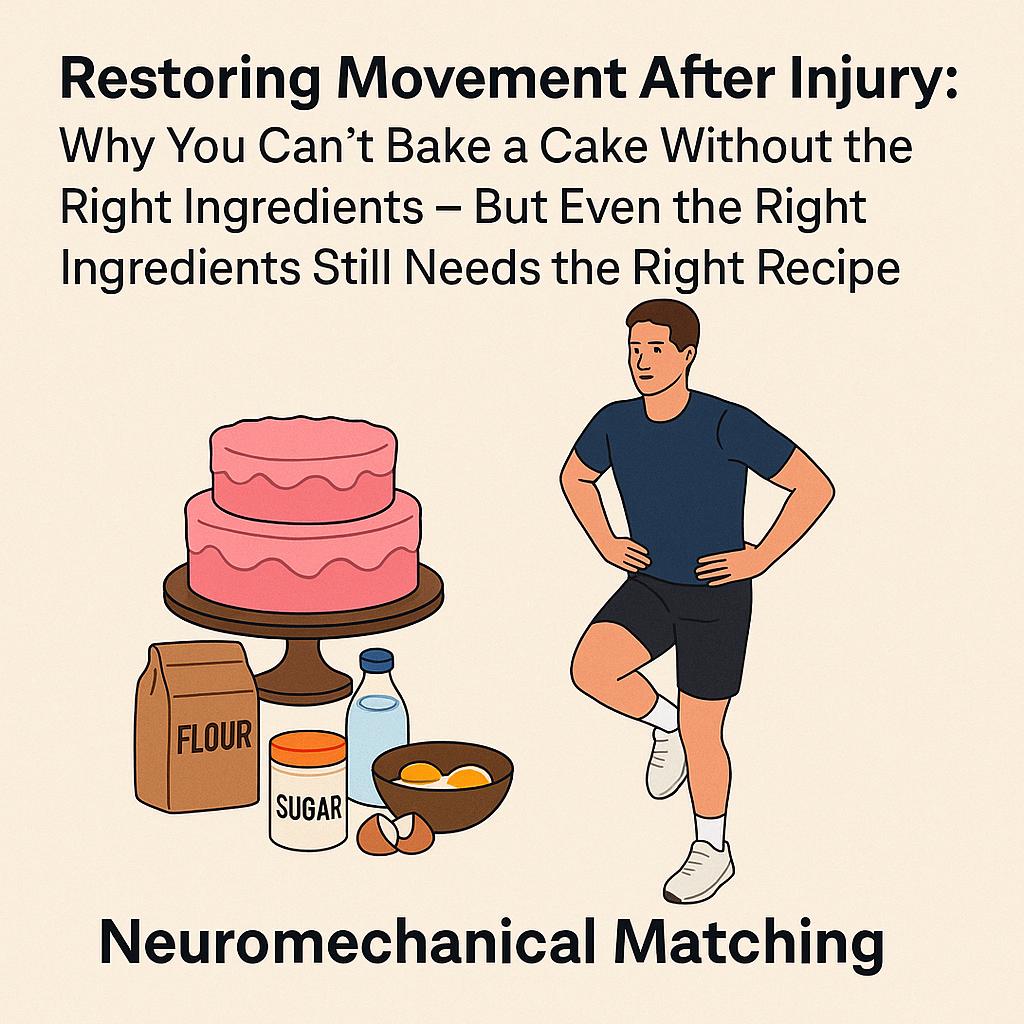Restoring Movement After ACL Injury: Why You Can’t Bake a Cake Without the Right Ingredients
Imagine trying to bake a cake, but you're missing eggs, your flour is stale, and the oven doesn’t heat properly.
You follow the recipe, shape it nicely, maybe even ice it to look right — but when you cut into it, it crumbles, collapses, or lacks substance. That’s what it’s like asking someone to land, hop, or jump “normally” after an ACL injury without first rebuilding the mechanical ingredients their body needs to support that movement.
This is the essence of neuromechanical matching — and it’s why restoring movement patterns after injury isn’t just about technique. It’s about giving the nervous system the raw materials it needs to cook up the right strategy.
The Single Leg Jump After ACLR: A Recipe with Missing Ingredients
Let’s take a single leg vertical jump post ACL reconstruction.
It’s a simple movement to watch — explode off the leg, control the landing. But under the surface, it’s a high demand task requiring:
- Coordinated triple extension (hip, knee, ankle)
- High rate of force development from the quads and glutes
- Tendon stiffness to store and release elastic energy
- A precise timing sequence to synchronize joint torque
- Confidence that the knee is stable and safe to load
In other words, a recipe full of complex, interdependent ingredients.
What Happens When Key Ingredients Are Missing?
After ACL surgery, several key components of this “cake” are missing or altered:
- Quadriceps inhibition (AMSI): The knee's main driver for propulsion and control is muted. The batter is thin.
- Reduced tendon stiffness: Especially in patellar tendon grafts. You’ve lost the spring — it’s like trying to bake without baking powder.
- Altered joint loading strategies: The brain doesn’t trust the knee, so it overuses the hip or contralateral side — like trying to hold up the cake with a spoon.
- Delayed or disorganized timing: If muscles don’t fire at the right time, movement is clunky and energy leaks occur — your cake is half-baked on one side.
- Fear and motor inhibition: Even when strength returns, the nervous system may still “flinch” under threat — the oven’s hot and no one wants to get burned again.
So Why Doesn’t the Body Go Back to the Old Recipe When Healed?
Even if you restock the pantry (strength, ROM, stiffness), the body won’t bake the old cake unless it re-learns how.
Why?
- The nervous system has adapted to use new recipes — protective, efficient, but not optimal.
- These new motor patterns are “good enough” to get by, so they become hardwired.
- Without specific cues, loading, and context, the CNS won’t update the motor program. It doesn’t assume the old pattern is safe just because the ingredients are back.
This is why someone might:
- Push off with less knee extension
- Use more hip strategy
- Avoid deep loading or rapid descent
…even with symmetrical strength numbers.
Restoring Neuromechanical Matching = Rebuilding the Kitchen
To truly restore movement post ACL, you need to:
Rebuild the mechanical system
- Restore quad strength (including rate of force, not just isometric peak torque)
- Recondition tendon stiffness and elastic behavior
- Address joint mobility and stability (especially tibial rotation, dorsiflexion, and hip extension)
Retrain the neural strategy
- Reinforce task-specific movement quality (e.g. forceful take-off from a deep position)
- Provide feedback and external cues to unlearn compensatory patterns
- Use variable and reactive environments to restore adaptable coordination
- Rebuild movement confidence and perceived safety
Movement Quality Depends on What’s in the Bowl
If the ingredients are missing, don’t expect a good cake.
If the ingredients are there but the chef is using the wrong recipe, you still won’t get what you’re after.
Great rehab is both a restocking process (mechanical) and a retraining process (neural). Both are needed to match the body’s available tools with the task it’s trying to perform.
Want help applying this to your own rehab program or athlete? Come and visit us at our Essendon or Williamstown clinic.
Let’s get baking.


